Sparks under the washing machine when washing
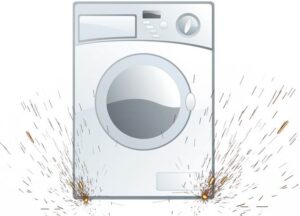 Any washing machine, like a vacuum cleaner, cannot be absolutely silent, so it is natural that the device makes noise during washing. Moreover, if the washing machine smells a little like plastic immediately after purchase, then this is also normal. But if the washing machine sparks from underneath the bottom, as if the device is about to take off like a rocket, then this is a sign of a major malfunction that cannot be left to chance. In this case, it is necessary to conduct a thorough diagnosis, and in case of breakdown, repair the household appliance.
Any washing machine, like a vacuum cleaner, cannot be absolutely silent, so it is natural that the device makes noise during washing. Moreover, if the washing machine smells a little like plastic immediately after purchase, then this is also normal. But if the washing machine sparks from underneath the bottom, as if the device is about to take off like a rocket, then this is a sign of a major malfunction that cannot be left to chance. In this case, it is necessary to conduct a thorough diagnosis, and in case of breakdown, repair the household appliance.
How does this technical anomaly manifest itself and when is it the norm?
If there is a spark under the washing machine during the operating cycle, then first of all, you need to disconnect the device from the power supply as quickly as possible. In such a situation, it is dangerous not only to use the machine, but even just to leave it connected to electricity. After de-energizing, you can begin diagnostics. Typically, sparks are a signal that there are problems with the washing machine, and they appear in different places.
- Sparking almost always occurs when washing or spinning is actively in progress. Then sparks during washing will appear under the drum at the back of the washing machine, where the electric motor is located. Not only will the crackling sound be louder than in normally functioning equipment, but if you turn off the lights, a small fireworks display will even become visible to the eye. In addition to the crackling sound, the phenomenon may be accompanied by a sharp smell of burning plastic, and sparks may even appear behind the drum, which can be seen through the glass of the machine door.
- Much less often, sparks may appear at the top of the “home assistant”, where the control panel is installed. After this, the device most often turns off, stops responding to any commands, and an unpleasant burning smell forms in the room.
Sparking can occur due to natural wear and tear on parts, damaged wiring, or a short circuit in the electronics. Due to the abundance of possible causes, only a household appliance repair specialist can accurately determine the problem, so if sparks occur, it is better to immediately call a technician.
Never use a sparking washing machine - this can permanently damage the equipment, damage the wiring in the house, and also cause a serious fire.
You can independently understand that there is nothing wrong with sparks and crackling, but only in two cases.
- If the automatic washing machine has recently been repaired, the electric motor or its brushes have been replaced;
- The washing machine is new, so it is just beginning to enter normal operating mode.
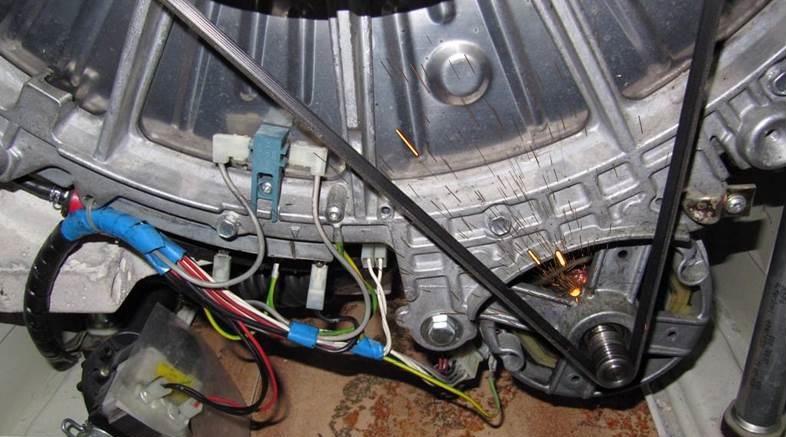
Both of these situations indicate that sparking occurs due to the grinding brushes of the device’s motor. During assembly and repair, the parts are installed correctly, but the commutator and brushes require a short grinding period, during which the notorious sparks occur with a bang.
To speed up the grinding, wash with a partial load, and also spin only at medium speed.
Typically, the grinding in is completed in a few washes, but occasionally up to ten work cycles may be required under light conditions. But if sparks appear during washing on old household appliances that no one has repaired or changed the motor with brushes, then there is definitely a breakdown in the machine.
There is a problem with the motor brushes
Most washing machines are equipped with commutator motors with graphite brushes that provide contact with the lamellas. The faster the rotation and the greater the load, the faster the brushes will wear out. It is they who, due to active use, wear out and cease to have normal contact with the collector, and then begin to spark.
When the washing machine sparks from below, there is an audible crackling sound, and in the dark the sparks look a little like fireworks, then most likely the problem is in the brushes. If you remove the back or side cover during sparking, which depends on the model of the washing machine - horizontal or vertical loading, you will be able to see sparks from the electric motor of the device.
To eliminate this malfunction, it is necessary to purchase new brushes and subsequently replace damaged parts. For this operation, it is better to call a service center specialist so that he can change the elements of the machine. This procedure on your own can cause difficulties due to the fact that if an old washing machine sparks from below, you will also have to disassemble the motor in which these brushes are hidden with your own hands. With new models of “home assistants” there will be fewer problems, because you will be able to do without disassembling the motor.
Engine slats peeling off
The contact surface of the commutator in contact with the brushes is called lamellas. During washing, they rotate, become very hot and gradually lose their smoothness. Washing without interruptions, and even with an overload of laundry, provokes serious overheating of the contact surfaces of the lamellas, after which the parts begin to deform and fail.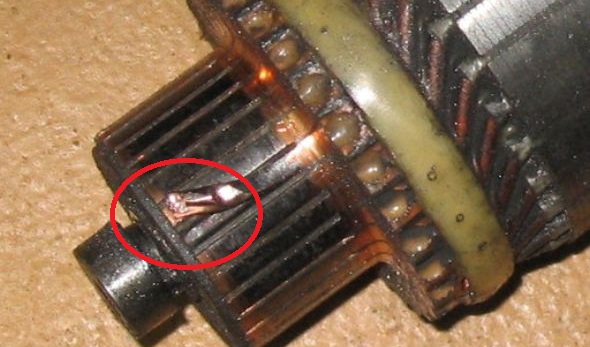
These plates can not only wear out, but also acquire a layer of soot. Due to the problems listed above, poor contact between the brushes and the commutator occurs, the washing machine motor begins to spark, and the brushes knock on the slats. The malfunction is easy to determine - just rotate the motor shaft with your own hands. If the lamellas are severely damaged, you will hear clicks and other atypical sounds that are not present on a normally functioning electric motor of the machine.
If the reason is in the lamellas, then at maximum load the equipment will spark, crackle and even knock loudly at high speeds during washing and spinning.
Eliminating this problem is possible by completely replacing the engine or by cleaning the lamellas. If the damage is minor, then the surfaces of the plates can be carefully treated first with sandpaper and then with felt. This will return the parts to their smoothness and uniformity of the contact field. If the lamellas are severely damaged, then it is impossible to repair them, so you will have to purchase a new washing machine motor, since equipment manufacturers do not sell separate spare parts for repairs.
Heating element problem
If the heating element is to blame, then sparking occurs due to its short circuit. Then the problem may be hidden in poor-quality contact in the wires due to oxidation or carbon deposits, as well as due to damage to the water heating element itself. If it burns out, the washing machine will immediately stop heating the water. But if the heating element shorts out a little, then it continues to work, but with sparks.Also, at the same time, the protection of the RCD, the automatic circuit breaker, or the machine on the power line of the washing machine can be activated.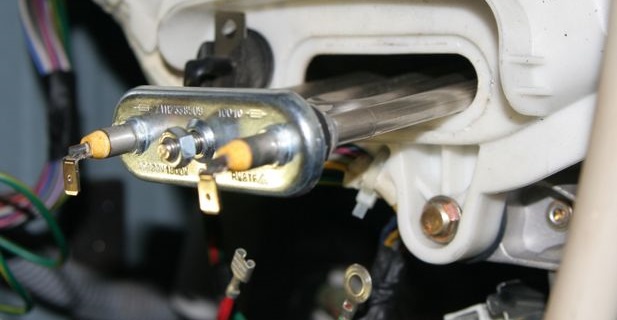
To determine that the problem is related specifically to the heating element, it is enough to see with your own eyes sparks or a glow at the bottom of the tank of the machine, which can be seen through the glass of the hatch. An unpleasant smell of burning plastic or wiring may also form. In rare situations, the device will independently activate the residual current device or circuit breaker.
A damaged heating element cannot be repaired, so replacing the part is necessary to fix the problem. As in the case of replacing brushes, to replace the heating element, we recommend calling a technician so that he can independently diagnose and determine whether the part needs to be replaced. In rare cases, the “home assistant” may spark due to poor-quality contact of the wiring of the water heating element. Then the specialist will clean the connections and tighten the fastening elements of the heating element.
Interesting:
Reader comments
- Share your opinion - leave a comment


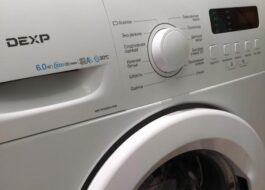


















Add a comment